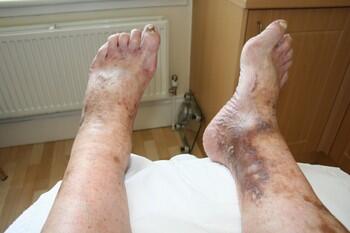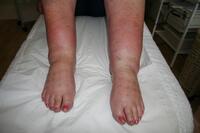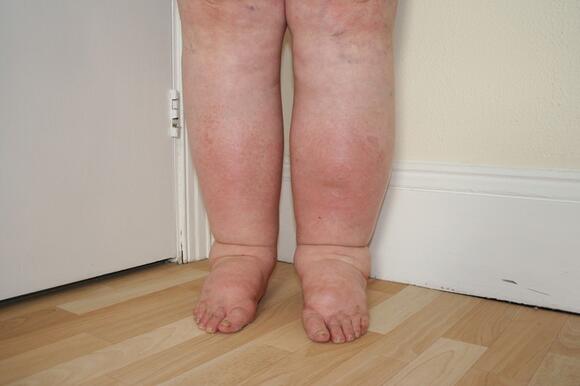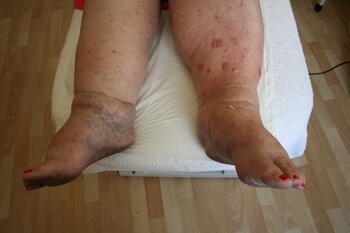
So very sad!
Lympheodema needs to be addressed in the very first stages, when the swelling develops. If he had been given early treatment, he would not be suffering like he is today.
Oedema - means swelling and inflammation caused by water retention
Oedema will show on your body as
Swelling or
Inflammation or
Fluid Retention and can be
Painful to touch
Any un-natural swelling anywhere on the body, means the body is in a sign of distress, it means it needs attention, sooner rather than later. We specialize in excess fluid retention conditions. These are often painful and tender to the touch and the first thing to go when you remove swelling is the pain! SO don`t suffer this agonising problem, if you have any swelling get it seen to.
Leaving fluid retention usually leads to other more complicated conditions and this kind of swelling will not go down with water retention tablets. WARNING - CONSISTANT AND PERSISTANT swelling is usually the first early warning signs of the medical condition called Lymphoedema, you are particularly vulnerable if you are very overweight or have had cancer or cellulitis.
Cellulitis
'You are more likely to be at risk of cellulitis if your ankles or legs have been swollen for some time with the swelling not going away.' Early signs of Lymphoedema or continuous oedema!'
This bacterial infection spreads rapidly and can be quite alarming and distressing. So, if you have a patch of skin that is red, warm and seems to be getting larger, then see a doctor as soon as possible.
With treatment, most people with cellulitis make a full recovery without any complications developing. If the cellulitis is severe before it is treated, it can leave long-term damage to lymph drainage from affected tissues.
This means that in some cases the swelling of tissues may remain, become worse, and can become permanent after the infection has gone.Lymphatic massage relieves aftermath of the symptoms of cellulitis.
If you have been left with swelling please get this swelling down through self-lymphatic massage or through a professional therapist who can reduce this which also reduces your risk of repeated infection.
What is cellulitis?
Cellulitis is a common infection of the lower layers of skin (dermis) and the areas underneath the skin it is caused by a bacterial infection. While cellulitis sometimes develops around wounds in the skin or surgical incisions, in other cases it can happen without an obvious source for infection.
What are the symptoms of cellulitis?
You may feel unwell and have a fever. Very often the first symptom is to feel feverish and shivery for up to 24 hours before any changes to the skin appear. A person with cellulitis can also develop swollen lymph nodes near to the area of the infection. Cellulitis usually begins as a small area of pain and redness on the skin. This area spreads to surrounding tissues, resulting in the typical signs of inflammation - redness, swelling, warmth, and pain.
Who is at risk for cellulitis?
Anyone may develop cellulitis. Males and females and people of all races are equally likely to become infected. However, people whose immune systems are weakened for any reason including chemotherapy, cancer or other immune-suppressing drugs and those with diabetes are at highest risk for developing cellulitis
What are risk factors for cellulitis?
Cellulitis is a common problem. It can affect anyone. However, there are some things that can make you more prone to cellulitis. For example, if you:
- Have athlete's foot
- Have skin abrasions (cuts, wounds).
- Have swollen legs (for various reasons),
- Are overweight or obese.
- Have previously had an episode of cellulitis.
- Have a poor immune system - for example, if you take steroids or chemotherapy, poor liver function.
- Have poorly-controlled diabetes.
- Have had an insect bite.
- Have skin problems such as eczema.
What causes cellulitis?
Most of cellulitis infections are caused by either staph (Staphylococcus) or strep (Streptococcus) bacteria. Staph (Staphylococcus aureus) is the most common bacteria that causes cellulitis.
How is it treated?
Usually with a 7-day course of antibiotics different cases may need more. If your symptoms do not start to clear within a few days of taking antibiotics please return to your GP, as sometimes different antibiotics are needed.
Erysipelas
Another form of rather superficial cellulitis caused by strep is called erysipelas; it is characterized by spreading hot, bright red circumscribed area on the skin with a sharp raised border. The strain of strep can sometimes rapidly destroy tissues. It is nearer to the skin surface than cellulitis. In reality, it is difficult to tell how deep an infection is, so cellulitis and erysipelas are much the same thing.
LYMPHOEDEMA is still happening!
Watch for early warning signs!
Any form of Chronic Lymphoedema when left untreated will eventually develop into a disfiguring and devastating condition, as shown in the video and pictures.
Depending upon the cause of the swelling, most cases unfortunately become severe because it is mis-diagnosed and mis-understood. In the early stages it is easy to live with until the fluid builds up and the pain starts effecting your ability to walk and mobility becomes unbearable and you are now facing disability. Swelling can continue slowly from over 5 - 40+ years. Ususally `wrongly` diagnosed as `water retention` or `fat legs`. This is NOT the CASE. These legs feel tight because the skin is stretched and they are extremely painful to the lightest touch, because they are full of fluid!!!!
VISIBLE WARNING Any continuous unknown swelling of the body unless immediately obvious as a result of pregnancy, injury or surgery, should NOT BE IGNORED.
If you are very overweight and have swollen ankles BE WARNED obesity is a known cause of lymphoedema.
Signs and symptoms to watch for..
- Continuous swelling/puffiness of the ankle or top of foot
- Visibly swollen, painful heavy legs, ankles and feet.
- If the swelling does not go down and leaves an indentation behind this is called Pitting.
(To check for Pitting, press your finger firmly into the swelling. If your finger print leaves an indentation as if pressing into Play-Doh or Dough, that means it does not go away, then you definately have a problem and you may have the first stages of Lymphoedema. You really need to start paying your legs some attention, immediately!)
Lipedema
LIPEDEMA
Your waist is much SMALLER in size compared to the width of your hips and your legs.
If you have Lipedema, these signs and symptoms can be mild or severe, this gives you valuable information as to why some women really cannot lose weight or inches off their legs and if this is you then there is actually a medical reason, please do not despair!
Early signs and symptoms can be severe sensitive cellulite or disproportionate obesity
Lipedema affects both sides of your thighs and is seen as a symmetrical, flabby swelling of the legs that form deposits of fat cells starting at the hips and ending at the ankles like riding breeches. In early stages the skin appears normal, but during progression of the disease the typical signs of standard `cellulite` can be observed.
Features include oedema (swelling) caused by an accumulation of high protein fluid in the cellular space, as well as the tendency to bruise very easily.
Fluid accumulation opens the pre-lymphatic drainage system, which results in the transport rate of the fluid towards the initial lymph capillary, massively decreased. Lymph capillaries of the skin show biological alterations or deformities, suggesting that lymph formation itself is impaired.
Some Complications
If you have had all of the above symptoms and have tried but failed to loose weight on your legs, even if you have lost several stone you may still have `fat or severe cellulite` legs, this is because your lymphatic system is impaired and not working properly.
Since Lipedema cannot be affected by diet or exercise these efforts are certain to fail. In some cases they might even result in severe eating disorders like bulimia or anorexia nervosa. Anxiety and depression, leads some Lipedema sufferers to try to achieve slimmer legs by intensive fasting or physical exercise.
The most common medically induced, complication is Pseudo-Bartter syndrome, which is caused by the chronic use of DIURETICS. Diuretics are of NO USE whatsoever in the treatment of Lipedema. It is a dysfunctional lymphatic system that needs manual treatment and compression garments - NOT A PILL.
Summary
- Usually and mainly found in women, can be painful to touch. Many of the above symptoms are mistaken and mis-diagnosed as being overweight.
- Lymph formation, lymph flow and removal of waste, fat and toxins are disturbed, leading to a combined form of lymphatic insufficiency.
- This medical condition is always classed with obesity and nearly impossible to diagnose without thorough palpable examination (touch) of the tissue and affected skin and its appearance
- Lipedema is NOT usually incorporated in medical diagnosis; suggested treatment is therefore diet and exercise, pills or surgery.
- Women often think about liposuction, BE WARNED there can be complications and consequences of this procedure, which affects the delicate lymphatic capillaries, as these are already impaired. This is usually because Lipedema is not recognised and goes undiagnosed.
- Lipedema can also be combined with mild or severe Lymphoedema called Lipo-lymphoedema. Rarely diagnosed among the medical profession as very little is understood for diagnosis of related signs and symptoms, you will just be given water tablets and told to diet!
This link below offers much more information about this condition should you wish to do further research.
http://www.tillysmidt.nl/LIPEDEMA%20%20Englisch%20for%20Lipoedeem.htm
CVI - Chronic Venous Insufficiency

Chronic Venous Insufficiency - CVI
Is a peripheral vascular disease. PVD. A prolonged condition in which one or more veins do not adequately return blood from the legs (lower extremities) back to the heart due to damaged venous valves. Symptoms include discoloration of the skin and ankles, swelling of the legs, and feelings of dull aching pain, heaviness, or cramping in the extremities.
What are the symptoms of peripheral vascular disease?
Approximately half the people diagnosed with peripheral vascular disease are symptom free. For those experiencing symptoms, the most common first symptom is intermittent claudication in the calf (leg discomfort described as painful cramping that occurs with exercise and is relieved by rest). During rest, the muscles need less blood flow, so the pain disappears. It may occur in one or both legs depending on the location of the clogged or narrowed artery.
Other symptoms of peripheral vascular disease may include:
- Changes in the skin, including decreased skin temperature, or thin, brittle shiny skin on the legs and feet
- Diminished pulses in the legs and the feet
- Gangrene (dead tissue due to lack of blood flow)
- Hair loss on the legs
- Impotence
- Non-healing wounds over pressure points, such as heels or ankles
- Numbness, weakness, or heaviness in muscles
- Pain (described as burning or aching) at rest, commonly in the toes and at night while lying flat
- Pallor (paleness) when the legs are elevated
- Reddish-blue discoloration of the extremities
- Restricted mobility
- Thickened, opaque toenails
tel 01273 441919






